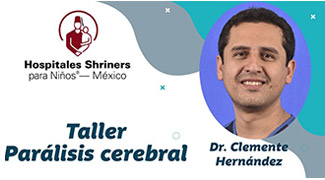Infantile cerebral palsy and its orthopedic treatment
How to Improve the Quality of Life of Children
On this occasion, we present a piece of what was the cerebral palsy workshop carried out by Dr. Hernández Gomez who told us about Infantile Cerebral Palsy and the treatment available at Shriners Hospital from the orthopedic point of view. Of you would like to see the full article, you can click on the video at the bottom. On the subject of paralysis, parents are so blocked in accepting that children can have this infirmity that they fall into two extremes, either they do not seek more information about it, or, on the other end, they seek too much information from unofficial sources.
How much do your know about the infirmity?
We need to understand the most basic and relevant information about this infirmity. At Shriners Hospital we provide orthopedic care in a comprehensive way, alongside other services such as physiotherapy for children with paralysis, but it is important to clarify the treatment goals, on an orthopedic level, that we can offer as an institution.
Types of Cerebral Palsy
The alterations of cerebral palsy cannot be perceived at birth. As the patient grows, it is possible to notice certain signs. From the orthopedic point of view, we can see that the feet go sideways, the hips are not the same, the hands do not have the same strength, etc. There are many types of cerebral palsy. In Mexico, most patients present spastic paralysis, which refers to the fact that the patient presents resistance and stiffness in the muscles and joints. Spasticity cannot be cured, but there are treatment to improve it. The minority of patients presents hypotonic, dyskinetic, or ataxic paralysis, meaning the patient has involuntary, and uncontrolled movements. These are automatic answers of the brain that cannot be controlled.
Changes in the Body
The central nervous system controls the entire body, depending on the brain’s level of involvement, it shoes which part of the patient’s body is going to be altered. If only one limb is altered such as an arm or a single foot, it is called Monoplegia. When the legs are more affected than the arms it is called Diplegia. When only half of the body is affected and the other half functions normally, it is called Hemiplegia. In the case of Quadriplegia, all four limbs, including the trunk, neck and head are affected.
What is the Gross Motor?
A term that patients commonly hear during their appointment is the so called “Gross Motor”. This refers to the motor activity capacities that the child develops as time goes by. It can be divided into five types:
Gross Motor 1- Refers to the fact that the patient can walk, go up and down stair without complications.
Gross Motor 2 - This is a patient who manages to walk, but going up and down stairs requires some sort of support.
Gross Motor 3 - Refers to patients who manage to walk, but require certain accessories to do so, such as a walker.
Gross Motor 4 - Refers to patients who cannot manage to walk, cannot stand, but can move in a wheelchair.
Last is Gross Motor 5 - Refers to children who cannot control the trunk, head, or limbs.
How does Shriners Hospital help these children?
Dr. Hernández says that support can be divided into three important points: prevention, correction, and quality of life.
In the case of prevention, there is no way to prevent the changes that derive from cerebral palsy. “We focus on the aftermath of these types of alterations as prevention. As time goes by, muscles make the hips move out of place and move away from the joint, for example. In a series of studies carried out to see which children require which type of treatment, so that the hip does not move from its correct placement,” comments Dr. Hernández.
In the case of correction, there are multiple treatments that can be performed from the orthopedic point of view. For example, in cases of clubfoot, the Achilles tendon is very contracted, so it is possible to extend the tendon through surgery giving it a plantigrade shape so the patient can support his foot correctly. This is just one example of the deformities that can be treated at the hospital. It is important to mention that at the moment, there is no surgical procedure capable of enabling a patient to regain gait in patients with ICP. This has to do with neurodevelopment. Therefore, early rehabilitation, stimulation, and physical therapy are very important. In the case of the Hospital, the intention is to improve the childrens’ position and function.
Quality of life
The hospital can help improve the quality of life of patients. An example would be in the use of certain types of footwear, the adaptation of wheelchairs; helping to remove pressure points in the body, all with the aim of improving the quality of life. “There are actions with which we also support parents or caregivers so they can help the children, such as cleaning. There are two children who cannot open their legs. This is where the hospital ventures into the modification of special chairs to ensure they can do more things from the orthopedic point of view,” says Dr. Hernández. As a Hospital, we as for your patience. To treat this infirmity it is necessary to collaborate as a team between doctors, parents, psychology and social work. We ask for your trust because what we do, as part of our mission, is aimed at improving the quality of life of each of our patients.

Restez en contact
Abonnez-vous à notre infolettre pour rester informé de tout ce qui se passe dans les Hôpitaux Shriners pour enfants.
